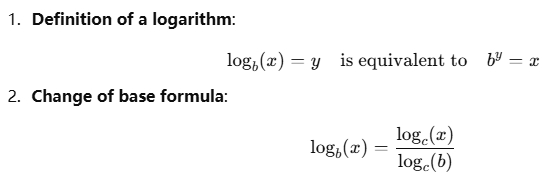Logarithmic Equation Calculator
A Logarithmic Equation Calculator is a tool designed to solve logarithmic equations, which are equations that involve logarithms (the inverse of exponentiation). Logarithmic equations can appear in a variety of fields, including mathematics, science, engineering, and finance. The calculator helps you solve for unknowns in these types of equations quickly and accurately.
Why use a Logarithmic Equation Calculator?
Logarithmic equations can be complex and tricky, especially when dealing with different logarithmic bases, exponents, and the need to simplify the equation. A calculator designed for logarithmic equations helps to:
- Save time: It automatically simplifies and solves logarithmic expressions, making the process faster than manual calculation.
- Avoid mistakes: Logarithmic equations often require specific rules for manipulation (like the change of base formula or logarithmic properties), and using a calculator reduces human error.
- Understand the process: Some calculators can show step-by-step solutions, helping you learn and understand how logarithmic equations are solved.
How does a Logarithmic Equation Calculator work?
Logarithmic equations often take the form:
logb(x)=yWhere:
- logb(x) represents the logarithm of x to the base b.
- The equation asks for the value of x, given the base bb b and the result y.
To solve logarithmic equations, you would typically use properties like:

For example, to solve log2(x)=3, you'd rewrite it as:
23=x⇒x=8The calculator handles these transformations and provides the solution.
When to use a Logarithmic Equation Calculator?
- Solving exponential and logarithmic problems: If you're working with equations where the unknown variable is in the exponent or logarithmic form, this tool can help you solve it.
- In advanced mathematics or physics: Logarithmic equations often appear in subjects like algebra, calculus, and physics, especially when dealing with growth, decay, and logarithmic scales (e.g., pH, decibels).
- In engineering: Logarithms are used in engineering fields for signal processing, electrical circuits, and other areas that involve exponential growth or decay.
- In finance and economics: Logarithmic equations are used to model compound interest, exponential growth, and other economic phenomena.
Example
Suppose we have the equation:
log3(x)=4To solve this:
- Rewrite using the definition of a logarithm: 34=x
- Calculate 34=81, so: x=81
The calculator would directly give you this result, potentially showing intermediate steps if needed.
More Complex Example
For an equation like log2(x)+log2(x−3)=3, you might need to combine the logarithms first before solving:
- Use the logarithmic property logb(a)+logb(c)=logb(ac): log2(x(x−3))=3
- Rewrite the equation using the definition: x(x−3)=23
- Solve the quadratic equation x2−3x=8, and find the value of x.
The calculator would take care of these steps and provide you with the final solution.